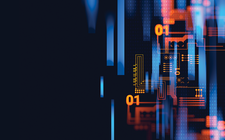Fuzzing and the quest for safer software
The Buzz on Fuzz

Fuzzing is an important method for finding bugs and security vulnerabilities in software. Read on to find out what fuzzing is and which methods are commonly used today.
It was a dark and stormy night. Bart Miller – you'll find an interview with him at the end of our feature – was working at home, connected by 1200-baud modem to the University of Wisconsin's mainframe computer. But every thunderclap meant that something went wrong: the lightning strikes disrupted data transmission over the phone line and garbled individual characters, forcing Miller to start over time and time again.
Each time he restarted, he noticed how many programs couldn't cope with disrupted data – they crashed, hung up, or otherwise stopped working in some uncontrollable way. Shouldn't programs do much better with invalid or glitched input? Miller decided to have his students systematically investigate this problem and gave them a programming assignment.
That night in the fall of 1988 is considered the birth of fuzz testing, by far the most important method today for testing programs for robustness and checking for security vulnerabilities. Professional programmers routinely use fuzzing to check for problems that could occur in the wild and might not be easy to anticipate. However, fuzzing is still a mystery to many part-time programmers and advanced users who program informally (including many in the Linux community). This month we take a close look at fuzzing and why it is so important.
[...]
Buy this article as PDF
(incl. VAT)
Buy Linux Magazine
Subscribe to our Linux Newsletters
Find Linux and Open Source Jobs
Subscribe to our ADMIN Newsletters
Support Our Work
Linux Magazine content is made possible with support from readers like you. Please consider contributing when you’ve found an article to be beneficial.

News
-
Manjaro 26.0 Primary Desktop Environments Default to Wayland
If you want to stick with X.Org, you'll be limited to the desktop environments you can choose.
-
Mozilla Plans to AI-ify Firefox
With a new CEO in control, Mozilla is doubling down on a strategy of trust, all the while leaning into AI.
-
Gnome Says No to AI-Generated Extensions
If you're a developer wanting to create a new Gnome extension, you'd best set aside that AI code generator, because the extension team will have none of that.
-
Parrot OS Switches to KDE Plasma Desktop
Yet another distro is making the move to the KDE Plasma desktop.
-
TUXEDO Announces Gemini 17
TUXEDO Computers has released the fourth generation of its Gemini laptop with plenty of updates.
-
Two New Distros Adopt Enlightenment
MX Moksha and AV Linux 25 join ranks with Bodhi Linux and embrace the Enlightenment desktop.
-
Solus Linux 4.8 Removes Python 2
Solus Linux 4.8 has been released with the latest Linux kernel, updated desktops, and a key removal.
-
Zorin OS 18 Hits over a Million Downloads
If you doubt Linux isn't gaining popularity, you only have to look at Zorin OS's download numbers.
-
TUXEDO Computers Scraps Snapdragon X1E-Based Laptop
Due to issues with a Snapdragon CPU, TUXEDO Computers has cancelled its plans to release a laptop based on this elite hardware.
-
Debian Unleashes Debian Libre Live
Debian Libre Live keeps your machine free of proprietary software.

